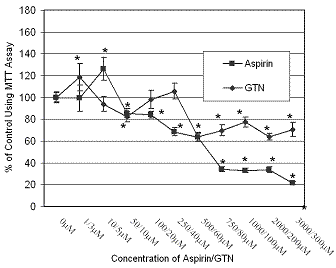| pA2 online © Copyright 2004 The British Pharmacological Society |
137P
University of Newcastle Winter Meeting December 2004 |
Aspirin and glyceryl trinitrate effects on polyamine uptake and smooth muscle cell growth Poh Lin, Winn1, Heather M. Wallace2, Brendan Clarke3, Karen Kelso4 and M. Helen Grant1. 1Bioengineering Unit and 3Dept. of Physiology & Pharmacology, University of Strathclyde, G4 ONW, 2Dept. of Medicine and Therapeutics, University of Aberdeen, AB25 2ZD, 4Vascutek, Inchinnan Industrial Estate, Paisley, PA4 9PR. |
|
Aspirin inhibits cell growth at high concentrations and stimulates cell growth at low concentrations in cultured human aortic vascular smooth muscle cells. Glyceryl trinitrate (GTN) is also found to inhibit smooth muscle cell (SMC) growth. From our data using the MTT test (Winn et al., 2004), GTN is a more potent inhibitor of SMC growth, but is less effective than aspirin. Hughes et al., (2003) showed that the toxicity of naproxen and sulindac in human colorectal cancer cells could be reversed by polyamines. We hypothesized that altered intracellular polyamine content could be involved in the mechanism of action of aspirin and GTN in SMC growth. To investigate this, primary cultures of pig coronary artery SMC (PCA) were used. Polyamine uptake was measured using a modification of the method described by Wallace and Mackarel, (1998). Cell cultures were treated with 18.5 kBq [3H]-putrescine/ml medium volume. After 3 days drug treatment, cells were scraped into 0.2M perchloric acid and incubated on ice for 15 min before scintillation counting. At the same time growth was measured by the MTT assay.
 |
Figure 1 MTT Assay in PCAs after three days drug treatment with aspirin and GTN. The y-axis shows % of control cell growth. * p<0.05, compared with the control values. ANOVA followed by Dunnett’s test. Results are mean ± SEM, n=10 . |
Aspirin (m M) |
Control |
1 |
50 |
3000 |
Polyamine Uptake |
90,891 ±7461 |
103,726 ±10632 |
270,329 ±29848** |
83,963 ±27200 |
GTN (m M) |
Control |
3 |
10 |
200 |
Polyamine Uptake |
268,498 ±16434 |
463,501 ±27123* |
243,915 ±70630 |
177,988 ±43034 |
Treated control values (ANOVA followed by Dunnett’s test)
Table 1 Polyamine uptake for PCAs when incubated with aspirin (above) and GTN (below). Results are mean ± SEM, n=4.
Figure 1 shows cell growth expressed as a % of control cell growth measured by MTT test for cells exposed to aspirin and GTN. High concentrations of GTN, and to a greater extent aspirin, significantly inhibited cell growth. However, low concentrations of aspirin and GTN stimulated cell growth. Table 1 shows an increase of polyamine uptake at low concentrations of both drugs in PCAs. At high concentrations of both drugs uptake returned to control levels. Our data shows that the uptake of polyamines increased as cell growth was stimulated supporting a link between polyamine concentrations and cell growth.
Hughes, A., Smith, M.I. and Wallace, H.M. (2003) Biochem. J. 374 481-488.
Wallace, H.M. and Mackarel, (1998) A.J. Biochem. Soc. Trans., 26 571-575.
Winn, P.L., Kelso, K. and Grant M.H., (2004) Toxicol., 194 241-242.